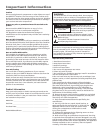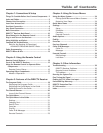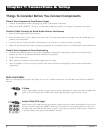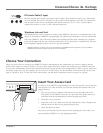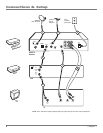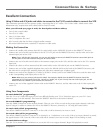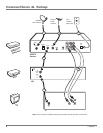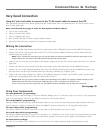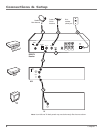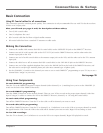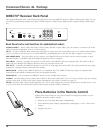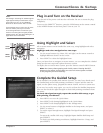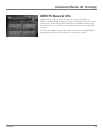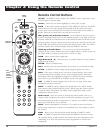
Connections & Setup
4 Chapter 1
Chapter 1 5
Connections & Setup
Excellent Connection
Using S-Video and A/V jacks and cables to connect to the TV, RF coaxial cables to connect the VCR
This connection provides the best picture quality, surpassing that of A/V cables. The S-Video cable, which carries video
information only, requires that audio cables also be used for sound.
What you will need (see pages 2 and 3 for descriptions of these cables):
• Two (2) RF coaxial cables
• Two (2) A/V cables
• One (1) S-Video cable
• One (1) telephone line cord
• RG-6 coaxial cable line fed from a digital satellite antenna
• RF coaxial cable line from a standard TV antenna or cable outlet
Making the Connection
1. Connect the satellite dish antenna feed (RG-6 coaxial cable) to the SATELLITE IN jack on the DIRECTV
®
Receiver.
2. Connect one end of an RF coaxial cable to the OUT TO TV jack on the DIRECTV Receiver, and the other end to the
antenna input jack on the VCR.
Note: If your VCR has A/V input jacks, you can use A/V cables to connect the DIRECTV Receiver’s second A/V jacks to
the A/V jacks of the VCR instead of using the RF coaxial cable.
3. Connect one end of an RF coaxial cable to the antenna output jack on the VCR, and the other end to the TV’s antenna
input jack.
4. Connect the cable or off-air antenna feed (RF coaxial cable) to the OFF AIR IN jack on the DIRECTV Receiver.
5. Connect one end of the supplied telephone line cord to the PHONE JACK on the back of the DIRECTV Receiver, and
the other end to an RJ11-type modular phone jack (the most common type of phone jack).
6. Connect two ends of the supplied A/V cables to AUDIO 1 R and L jacks on the DIRECTV Receiver, and the other ends
to the corresponding audio input jacks on the TV.
Note: Make sure you connect jacks by their labels. For example, AUDIO R on the DIRECTV Receiver should be
connected to TV’s right audio input jack, L Audio to L Audio, etc. If your TV only has one audio input jack, use the
DIRECTV Receiver’s AUDIO L jack to make the connection.
7. Connect one end of the supplied S-Video cable to the DIRECTV Receiver, and the other end to the S-Video input jack
on the TV.
Go to page 10
Using Your Components
To watch DIRECTV
®
programming:
Tune the TV to its S-Video line input (if you have difculty nding your TV’s S-Video line input, see your TV’s User’s
Manual or page 41 in this manual). Then tune the DIRECTV Receiver to the desired channel.
To record DIRECTV programming:
Tune the DIRECTV Receiver to the desired channel. Then set your VCR to record on the proper input channel (video line
input if using A/V cables to connect the VCR to the DIRECTV Receiver, channel 3 or 4 if using RF coaxial cable).
To watch cable/off-air programming:
Turn off the DIRECTV Receiver. Tune the TV to the cable or off-air channel you want to watch.
To record cable/off-air programming:
Turn off the DIRECTV Receiver. Tune the TV to channel 3 or 4 (whichever is set on the VCR as its output channel) to watch
the signal from the VCR. Tune the VCR to the cable/off-air channel you want to watch. Begin VCR recording as usual.
To watch VCR recordings:
Tune the TV to channel 3 or 4 (whichever is set on the VCR as its output channel). Begin VCR playback as usual.




